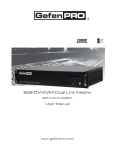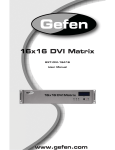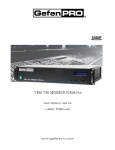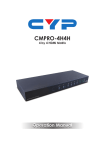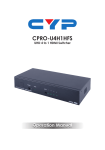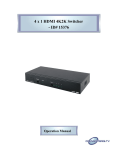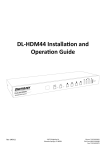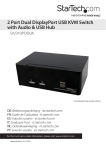Download Gefen GEF-DVI-1044DL video switch
Transcript
10x4 DVI Dual Link Matrix GEF-DVI-1044DL User Manual www.gefenpro.com ASKING FOR ASSISTANCE Technical Support: Telephone Fax (818) 772-9100 (800) 545-6900 (818) 772-9120 Technical Support Hours: 8:00 AM to 5:00 PM Monday thru Friday, Pacific Time Write To: Gefen LLC c/o Customer Service 20600 Nordhoff St Chatsworth, CA 91311 www.gefenpro.com [email protected] Notice Gefen LLC reserves the right to make changes in the hardware, packaging and any accompanying documentation without prior written notice. 10x4 DVI Dual Link Matrix is a trademark of Gefen LLC © 2010 Gefen LLC, All Rights Reserved All trademarks are the property of their respective owners Rev A1 1.8 CONTENTS 1 Introduction 2 Operation Notes 3 Features 4 Panel Layout 5 Panel Descriptions 6 Connecting And Operating The 10x4 DVI Dual Link Matrix 7 Front Panel Controls 7 Routing a Source to One Monitor 8 Routing a Source to Multiple Monitors at Once 10 Masking Outputs 11 Unmasking Outputs 12 IR Remote Description 13 IR Remote Installation 14 IR Code Configuration 15 EDID Management Feature 16 RS-232 Serial Control 16 Settings 17 EDID Management 22 IP Configuration 26 General Functions 29 Commands 31 IP Control 31 Manage EDID 35 Masking 36 Configuration 37 Backup / Restore & Power Management 38 Firmware Update 40 Specifications 41 Warranty 42 Licensing INTRODUCTION Congratulations on your purchase of the GefenPRO 10x4 DVI Dual Link Matrix. Your complete satisfaction is very important to us. GefenPRO In the realm of video distribution, certain features are invaluable in a commercial or broadcast environment. Accommodations such as a build-in power supply and flat black rack-mount enclosures set GefenPRO apart from our traditional products. Complex distribution units allow for professional DVI, 3G-SDI, and HDMI signals to be routed and converted easily and seamlessly, while being backed up by a renowned and dependable technical support team. Gefen invites you to explore the GefenPRO product line and hopes that you find the solution that fits your needs. The GefenPRO 10x4 DVI Dual Link Matrix Simplify the process of routing up to 10 DVI sources to any of 4 DVI monitors without losing quality or resolution. The GefenPRO 10x4 DVI Dual Link Matrix provides a simple, reliable, and highly effective method of streamlining any installation using multiple sources and outputs, taking the hassle out of managing multiple connections. Each DVI source is accessible at all times by any monitor using the front-panel buttons, IR remote unit, built-in RS-232 or using IP control. How It Works Using the supplied DVI cables, connect 10 sources to the DVI input ports on the GefenPRO 10x4 DVI Dual Link Matrix. Connect the 4 DVI monitors to the DVI outputs on the GefenPRO 10x4 DVI Dual Link Matrix. Plug in the power cord and power-on the GefenPRO 10x4 DVI Dual Link Matrix. The connected monitors will show video according to the routing selection. NOTE: The GefenPRO 10x4 DVI Dual Link Matrix only supports DVI-D. The DVI connectors on the 10x4 DVI Dual Link Matrix have all 29 pins. 1 OPERATION NOTES READ THESE NOTES BEFORE INSTALLING OR OPERATING THE GEFENPRO 10X4 DVI DUAL LINK MATRIX • The 10x4 DVI Dual Link Matrix does not support HDCP content. • Make sure that a DVI monitor is powered and connected to one of the DVI outputs on the 10x4 DVI Dual Link Matrix before applying power. By default, the Local EDID is read from the connected monitor and is copied to all 10 DVI inputs once the Matrix has been turned on. If a monitor is not detected by the Matrix at power-on, a default (internal) EDID of 640x480 will be used. This functionality can be disabled using the Secure Local EDID function through IP control. See page 30 for more information. • There is no internal scaling in the 10x4 DVI Dual Link Matrix. Each monitor attached to the Matrix must be able to display the resolutions output by the source device(s). For maximum compatibility it is recommended that only one common resolution be used by each source device. • Advanced EDID features and IP configuration features are accessible through the RS-232 serial command set. • Routing and EDID features can be accessed using a Web browser using the built-in IP control. 2 FEATURES Features • Increases productivity • Supports resolutions up to 3840x2400 • Front panel control buttons for local switching • IP Control • Serial RS-232 interface for remote control via a computer or control automation devices • Discrete IR remote control • Advanced EDID management permits uploading of custom internal or external EDID settings • Supports DDWG standards for DVI • Internal power supply • Output masking command • Standby mode • Energy Star compliant • Grounding pin • IR Sensor • IR Extender • Power On/Off switch • Status LCD (shows routing status) • Rack mountable Package Includes (1) GefenPRO 10x4 DVI Dual Link Matrix (16) 6-foot DVI cable (M-M) (1) 6-foot serial DB9 cable (M-F) (1) IR remote control unit (1) AC Power Cord (1) User Manual 3 PANEL LAYOUT Front Panel 3 1 2 4 Back Panel 10 5 6 7 8 4 9 PANEL DESCRIPTIONS 1 OFF Button Use this button to mask selected outputs. See page ## for details. 2 Input Selection Buttons 1-10 These buttons are used to select the input source. 3 Output Selection Buttons 1-4 These buttons are used to select the output. 4 Routing State Indicators These LED indicators show the current routing state. 5 RS-232 Serial Port Connects to the RS-232 control device. The 10x4 DVI Dual Link Matrix may be switched remotely using this port. See page 24 for more information. 6 AC 110/220V (50/60 Hz) Power Cable / Receptacle Connect the included AC power cord from this receptacle to an available electrical outlet.. 7 Power Switch Turn the power ON or OFF using this switch. The switch will glow bright green when the Matrix is turned ON. 8 DVI Input Ports 1-10 Connect DVI source devices to these ports. 9 Grounding Terminal Provides a discharge path to ground in case a short circuit occurs between the “hot” lead of the power supply and the enclosure of the Matrix. The grounding wire should be attached from the grounding terminal to an approved ground path. 10 DVI Output Ports 1-4 Connect DVI monitors to these ports. 5 CONNECTING AND OPERATING THE 10X4 DVI DUAL LINK MATRIX How to Connect the 10x4 DVI Dual Link Matrix 1. Connect up to 10 DVI source devices to the DVI inputs on the rear panel of the 10x4 DVI Dual Link Matrix using the supplied DVI cables. 2. Connect up to 4 DVI monitors to the DVI outputs on the rear panel of the 10x4 DVI Dual Link Matrix with user-supplied DVI cables. 3. Connect the included AC power cable to the power receptacle on the rear panel of the 10x4 DVI Dual Link Matrix. Connect the opposite end of the cable into an available electrical outlet. 4. Power on the monitors and the source devices. Turn on the 10x4 DVI Dual Link Matrix by pressing the power switch on the front panel. How to Operate the 10x4 DVI Dual Link Matrix The 10x4 DVI Dual Link Matrix offers a number of control options. The following methods can be used to control basic routing functions of the 10x4 DVI Dual Link Matrix: 1. Front Panel Control Buttons - Pages 7 and 8 2. IR Remote Control - Pages 9 and 10 3. RS-232 Serial Control - Pages 16 - 30 4. IP Control - Pages 26 - 33 DVI DUAL LINK CABLE 10x DVI Dual Link Sources Matrix 4x DVI Dual Link Displays 6 GEF-DVI-1044DL CONNECTING AND OPERATING THE 10X4 DVI DUAL LINK MATRIX Front Panel Controls The GefenPRO 10x4 DVI Dual Link Matrix uses an LED display that shows the current routing status and is used to control the Matrix. When the unit is powered, four (4) LEDs will indicate the current routing status: In the example above, all DVI sources have been routed to Output 1. The top row of ten (10) buttons correspond to each input on the Matrix. The four buttons on the left correspond to each of the outputs on the Matrix (see pages 4 and 5). The GefenPRO 10x4 DVI Dual Link Matrix can route a source to one monitor at a time or a source to multiple monitors at once. Routing a source to a monitor is a two-step process: The first step is to select the monitor (1-4) to which the source will be routed. The second step is to select the source (1-10). Routing a Source to a Monitor Example 1: Route the source device connected to In 2 to the monitor connected to Out 1. 1. Press the Output 1 button. The Ouput 1 button will glow blue, indicating that it has been pressed. 7 CONNECTING AND OPERATING THE 10X4 DVI DUAL LINK MATRIX 2. Press the Input 2 button. The Input 2 button will glow blue momentarily and the LED will change from Input 1 to Inputt 2. The Input 2 and for Output 1 buttons will turn off. The source connected to Input 2 should now be displayed on the monitor connected to Output 1. Routing a Source to Multiple Monitors at Once Example 2: Route the source device connected to In 3 to the monitors connected Out 2, Out3, and Out4. 1. Press the buttons for Output 2, Output 3, and Output 4. Each button will glow blue, indicating that it has been pressed. 8 CONNECTING AND OPERATING THE 10X4 DVI DUAL LINK MATRIX 2. Press the button for Input 3. The button for Input 3 will glow blue momentarily and each LED will change from Input 1 to Input 3. In the example above, Input 3 has been routed to Outputs 2, 3, and 4. From the previous example (see page 7), Input 2 has been routed to Output 1. 9 CONNECTING AND OPERATING THE 10X4 DVI DUAL LINK MATRIX Masking Outputs Any monitor can be blocked (masked) from displaying video. A single monitor or multiple monitors can be masked at any one time. Example 1: Masking Output 2 and Output 3. 1. Press the buttons for Output 2 and Output 3. Each button will glow blue, g that it has been pressed. p indicating 2. Press far-left buttons. ss the Off button, located at the far left of the Input b The Off button will glow blue momentarily. The buttons for Output 2 and Output 3 will turn off and video will not be transmitted to Output 2 and Output 3. 10 CONNECTING AND OPERATING THE 10X4 DVI DUAL LINK MATRIX Unmasking Outputs Example 1: Unmasking Output 2 and Output 3. 1. Press the buttons for Output 2 and Output 3. Each button will glow blue, indicating that it has been pressed. 2. Press the Off button, located at the far-left of the Input buttons. The Off button will glow blue momentarily and the LED indicators for Output 2 and Output 3 will glow blue. The Off, Output 2, and Output 3 buttons will turn off and video should now be restored to monitor 2 and monitor 3. 11 IR REMOTE DESCRIPTION RMT-8IR Remote Control Unit 1 2 1 Activity Indicator This LED will be activated momentarily each time a button is pressed. 2 Display and Source Selection Buttons These buttons are used to select which source is routed to a monitor. Routing Sources using the Remote Control unit Issuing a routing command is a two step process. The first step is to select the monitor (1-4) to which the source will be routed. The second step is to select the source (1-10). Example: Route the source device connected to In 6 to the monitor connected to Out 4. 1. Press button 4 (Out 4) on the IR remote control unit. 2. Press button 6 (In 6) on the IR remote control unit. The source connected to In 6 will be routed to the monitor connected to Out 4. 12 IR REMOTE INSTALLATION Installing the RMT-8IR Battery 1. Remove the battery cover on the back of the IR Remote Control unit. 2. Insert the included battery into the open battery slot. The positive (+) side of the battery should be facing up. 3. Replace the battery cover. The Remote Control unit ships with two batteries. One battery is required for operation and the other battery is a spare. Empty Battery Slot IR Code Dip Switches 13 IR REMOTE CONFIGURATION How to Resolve IR Code Conflicts In the event that IR commands from other remote controls interfere with the supplied IR Remote Control unit, changing the IR Remote Control’s IR channel will fix the problem. The IR Remote Control unit has a bank of DIP switches used for setting the IR channel. The DIP switch bank is located underneath the battery cover. Remote Channel 0: Default Remote Channel 1: 1 2 Remote Channel 2: 1 2 1 2 Remote Channel 3: 1 2 Left: Picture of the opened rear battery compartment of the IR remote showing the exposed DIP Switch bank between the battery chambers. It is important that the IR channel on the Remote Control unit, matches the IR channel set on the 10x4 DVI Dual Link Matrix. For example, if both DIP switches on the IR Remote Control unit are set to IR channel 0 (both DIP switches down), then the 10x4 DVI Dual Link Matrix must also be set to IR channel 0. See page 22 on how to change the IR channel on the 10x4 DVI Dual Link Matrix. 14 EDID MANAGEMENT FEATURE EDID. What is it and what is it used for? Under normal circumstances, a source device (digital and analog) will require information about a connected device/display to assess what resolutions and features are available. The source can then tailor its output to send only resolutions and features that are compatible with the attached device/ display. This information is called EDID (Extended Display Information Data) and a source device can only accept and read one EDID from a connected device/display. Likewise, the source an only output one resolution for use by a connected device/display. Why is EDID so important with the 10x4 DVI Dual Link Matrix? The 10x4 DVI Dual Link Matrix is a complex piece of technology that replicates and switches between multiple inputs and outputs. Each connected source device will require one EDID to read. EDID management is carefully handled by the 10x4 DVI Dual Link Matrix to provide a single EDID for each source to read. What options do I have to manage the EDID in the 10x4 DVI Dual Link Matrix? First, it is important to note that each source device can only output one video/ audio signal type. This includes resolutions and timings. When multiple devices/ displays are used, such as with the 10x4 DVI Dual Link Matrix, it is important to use devices/displays that have similar or compatible resolutions and features. This will ensure that the single video/audio signal produced by the source device is accepted by all of the connected output devices/displays. The user has the option, through utilization of the RS-232 serial interface, to choose how the unit will manage the EDID from multiple DVI devices/displays. Therefore the user has some control over the resolutions and features that the source devices will output. The 10x4 DVI Dual Link Matrix has a LOCAL EDID management mode that will control how the EDID information is handled. How do I change EDID modes in the 10x4 DVI Dual Link Matrix? EDID modes and IP configuration is managed via the RS-232 serial communications port. See page 13 for more information on the RS-232 serial communication features. 15 RS-232 SERIAL CONTROL What features are available via the RS-232 serial communications port? The 10x4 DVI Dual Link Matrix Switcher can accept commands through the RS232 serial communications port located on the rear panel. The current RS-232 control features are: • Switching/routing of inputs to outputs without the IR remote control. • Managing the EDID bank and EDID that is loaded into the LOCAL EDID. • Upload new EDID’s to the EDID bank or directly to the LOCAL EDID location. • Manage IP settings. How do I use these features? These features were initially intended for utilization by custom installers in automated setups. However, these features can be tested and used by using any Windows PC with a terminal program. What pins are used for communication with the 10x4 DVI Dual Link Matrix Switcher? Only pins 2 (Receive), 3 (Transmit), and 5 (Ground) are used for communication. A null-modem adapter should not be used with this product. 54321 12345 9876 6789 Only Pins 2 (RX), 3 (TX), and 5 (Ground) are used on the RS-232 serial interface RS-232 Settings Bits per second ............................................................................................ 19200 Data bits ............................................................................................................... 8 Parity ............................................................................................................. None Stop bits ................................................................................................................1 Flow Control .................................................................................................. None 16 RS-232 SERIAL CONTROL RS-232 Features RS-232 remote functions are used to control of this product’s features. Features include input to output routing, EDID storage, EDID management, etc. These functions are available only through the use of the serial port. Functions Syntax The syntax for each function is always the same: Character as the start flag → Function name → Space ( _ ) as function name end flag → Parameter 1 → Space → Parameter n → Carriage Return ( \r ) → Sample: #FunctionName_param1_param2_param3_param4...\r Syntax is NOT case sensitive. Function list EDID Management Function Description #EDIDDSTOLO Read downstream EDID and stores into a Local EDID #EDIDDSTOBA Read downstream EDID and stores in EDID Bank #EDIDBATOLO Read downstream EDID and stores in any Local Input #EDIDDETOLO Sets Local EDID to Default EDID #LOCKEDID Secures Local EDID #LOEDIDTOLO Load EDID file using serial port to one of the local memories #PRLOEDID Read Input Local EDID and sends to serial port #PRDSEDID Read downstream EDID and sends to serial port #PRBAEDID Read downstream EDID from bank and sends to serial port #PREDIDST Prints EDID details 17 RS-232 SERIAL CONTROL #EDIDDSTOLO Function The #EDIDDSTOLO function reads the downstream EDID and stores it to a Local EDID input. Syntax: #EDIDDSTOLO param1 param2 [param3...param9] Parameters: param1 A downstream monitor [1 - 4] param2 Input list [1 - 10] Notes: If param2 = 0, then the downstream EDID is stored to all 10 DVI inputs. Examples: #EDIDDSTOLO 2 1 2 3 4 5 inputs 1-5 use display 2 EDID #EDIDDSTOLO 3 0 all inputs use display 3 EDID #EDIDDSTOBA Function The #EDIDDSTOBA function reads the downstream EDID and stores it to a specified EDID bank. Syntax: #EDIDDSTOBA param1 param2 Parameters: param1 A downstream monitor [1 - 4] param2 EDID bank offset [1 - 5] 18 RS-232 SERIAL CONTROL #EDIDBATOLO Function The #EDIDBATOLO function reads the downstream EDID and stores it to any local input. Syntax: #EDIDBATOLO param1 param2 [param3...param9] Parameters: param1 EDID bank offset [1 - 5] param2 Input [1 - 10] Notes: If param2 = 0, then the EDID in the specified bank is copied to all eight inputs. #EDIDDETOLO Function The #EDIDDETOLO function stores the Default EDID (640x480) in the specified Local EDID inputs. Syntax: #EDIDDETOLO param1 param2 param3...param9 param1 Input [1 - 10] Notes: If param1 = 0, then all 10 DVI inputs will be set to the Default EDID. 19 RS-232 SERIAL CONTROL #LOCKEDID Function The #LOCKEDID function secures the Local EDID and disables the automatic loading of the downstream EDID after the Matrix is powered on. Syntax: #LOCKEDID param1 Parameters: param1 Input [0 - 1] Value Meaning 0 Disable 1 Enable #LOEDIDTOLO Function The #LOEDIDTOLO function loads an external EDID via RS-232 to any Local EDID input bank. Syntax: #LOEDIDTOLO param1 param2 param3 Parameters: param1 Input [1 - 10] param2 EDID size [1 - 2] param3 Value Meaning 1 128 byte EDID 2 256 byte EDID eco [0 - 1] Notes: Set param1 to a value of 0 in order to specify all inputs. When using HyperTerminal, param3 must be set to 1. 20 RS-232 SERIAL CONTROL #PRDSEDID Function The #PRDSEDID function reads the downstream EDID and sends it to the serial port. Syntax: #PRDSEDID param1 Parameters: param1 A downstream monitor [1 - 4] #PRLOEDID Function The #PRLOEDID function reads the local EDID of a specified input and spools it to the serial port. Syntax: #PRLOEDID param1 Parameters: param1 A specified Input [1 - 10] #PRBAEDID Function The #PRBAEDID function reads the EDID file from the specified bank and sends to serial port. Syntax: #PRBAEDID param1 Parameters: param1 Input [1 - 5] 21 RS-232 SERIAL CONTROL #PREDIDST Function The #PREDIDST function reads the downstream EDID. This function displays a table containing details relating to the Local EDID and the monitor name. Syntax: #PRDSEDID Parameters: None IP Configuration (currently not supported) Function Description #PRWEBADD Displays the Web configuration #RSTIP Set IP configuration to default #SIPADD Specifies a new IP address #SNETMASK Specifies a new net mask #SGATEWAY Specifies the new gateway #SPORT Specifies a new port #PRWEBADD Function The #PRWEBADD displays the IP address, net mask, gateway, MAC address, and port on the screen. Syntax: #PRWEBADD Parameters: None 22 RS-232 SERIAL CONTROL #RSTIP Function The #RSTIP function sets the IP configuration to the default settings. Syntax: #RSTIP Parameters: None #SIPADD Function The #SIPADD function specifies a new IP address. Syntax: #SIPADD param1 param2 param3 param4 Parameters: param1 IP address [0 - 255] param2 IP address [0 - 255] param3 IP address [0 - 255] param4 IP address [0 - 255] Notes: A reboot is required after the new IP address is set. 23 RS-232 SERIAL CONTROL #SNETMASK Function The #SNETMASK function specifies a new net mask. Syntax: #SNETMASK param1 param2 param3 param4 Parameters: param1 IP address [0 - 255] param2 IP address [0 - 255] param3 IP address [0 - 255] param4 IP address [0 - 255] Notes: A reboot is required after the new IP address is set. #SGATEWAY Function Specifies the new IP gateway. Syntax: #SGATEWAY param1 param2 param3 param4 Parameters: param1 Gateway address [0 - 255] param2 Gateway address [0 - 255] param3 Gateway address [0 - 255] param4 Gateway address [0 - 255] Notes: A reboot is required after the gateway address has been assigned. 24 RS-232 SERIAL CONTROL #SPORT Function Specifies a new port. Syntax: #SPORT param1 Parameters: param1 Port [0 - 255] Notes: A reboot is required after the gateway address has been assigned. #PRWEBADD Function Prints the current IP configuration on the screen. Syntax: #PRWEBADD Parameters: None Notes: A reboot is required after the gateway address has been assigned. 25 RS-232 SERIAL CONTROL General Functions Function Description #ACTIVEBOLO Enables the boot loader #FADEFAULT Set matrix local and routing status to default settings #LOCKPOWER Toggles the lock power state #MASKOUT Blanks selected outputs #RMTIRADD Set the remote IR channel #STBYMODE Sets the Matrix to Standby Mode #ACTIVEBOLO Function The #ACTIVEBOLO function enables the boot loader allowing the Matrix to be updated with firmware using RS-232. Syntax: #ACTIVEBOLO Parameters: None Notes: The #ACTIVEBOLO command must be typed twice in order to activate the boot loader. #FADEFAULT Function The #FADEFAULT function sets all Local EDIDs and routing settings to default. Syntax: #FADEFAULT Parameters: None 26 RS-232 SERIAL CONTROL #LOCKPOWER Function The #LOCKPOWER enables/disables the power lock state. Enabling this feature will store the 5V status for each input prior to shutting the unit down. This preserves the 5V state when the Matrix is restarted. Syntax: #LOCKPOWER param1 Parameters: param1 State [0 - 1] Value Meaning 0 Disable Power Lock 1 Enable Power Lock #MASKOUT Function The #MASKOUT function allows blanking or selected outputs. Syntax: #MASKOUT param1 param2 Parameters: param1 Output [1 - 4] param2 Output [1 - 4] Notes: The current masking state will be lost if power is lost. 27 RS-232 SERIAL CONTROL #RMTIRADD Function The #RMTIRADD function set the remote IR channel. Syntax: #RMTIRADD param1 Parameters: param1 IR channel [0 - 3] #STBYMODE Function The #STBYMODE function disables / enables standby power mode. Syntax: #STBYMODE param1 Parameters: param1 Disable / Enable [0 - 1] Value Meaning 0 Disable Standby Mode 1 Enable Standby Mode 28 RS-232 SERIAL CONTROL Commands Command Description R Routing command S Routes a single input to all outputs M Returns the current routing status of matrix F Toggle 5V fiber optic extender feature R Command The R command allows specific routing of inputs and outputs. Syntax: r param1 param2 Parameters: param1 DVI Ouput [1 - 4] param2 DVI Input [1 - 10] S Command The S command routes a single input to all 10 DVI outputs. Syntax: s param1 Parameters: param1 Input [1 - 10] Notes: Setting param1 to a value of 0 will place the matrix in one-to-one mode. This means that Input 1 will be routed to Output 1, Input 2 will be routed to Output 2, and so on. 29 RS-232 SERIAL CONTROL M Command The M command displays the current routing status of the matrix. Syntax: m Parameters: None F Command The F command returns the state of pin 14 of the DVI inputs. Syntax: f param1 param2 Parameters: param1 DVI input [1 - 10] param2 State [0 - 1] Notes: “High” is returned if +5V is enabled on the DVI input. “Low” is returned if +5V is disabled on the DVI input. 30 IP CONTROL - MANAGE EDID MANAGE EDID The Manage EDID page is used to see the status of the EDID saved in the local storage location for each input. This section has additional tabs for advanced EDID functions. These tabs are: • SET INPUT TO DEFAULT EDID • UPLOAD EDID (Future Implementation) • DOWNLOAD EDID (Future Implementation) • COPY EDID • EDID LOCK STATE This page will automatically refresh every minute. However, at anytime the REFRESH button can be pressed to return the current status of the Matrix. 31 IP CONTROL - MANAGE EDID SET INPUT TO DEFAULT EDID Pressing the SET INPUT TO DEFAULT EDID button will display additional options. The following page will open. On this page, local memory locations can be selected to receive the built-in EDID stored in the 10x4 DVI Dual Link Matrix. To set an input’s local memory location to the default EDID follow the steps below. 1. Select any number of inputs by clicking on the desired checkboxes. 2. Click on the Set Default EDID button to update the change(s). Note: After this command is complete the Web Interface will return to the VIEW MATRIX STATUS page. This page will automatically refresh every minute. However, the REFRESH button can be pressed at any time to return the current status of the Matrix. 32 IP CONTROL - MANAGE EDID COPY EDID Pressing the COPY EDID button will display additional options. The following page will open. On this page, the user can select an EDID from either the local memory locations (Input) or from a monitor that is currently attached to any output and copy that EDID to any other LOCAL memory location. This will permits control of what EDID information will be passed to each source connected to the 10x4 DVI Dual Link Matrix. To copy an EDID follow the steps below. 1. Select an EDID from the Select Source to Copy from section. An EDID can be selected from a monitor connected to one of the outputs or from an EDID already loaded into one of the local memory locations (Input). It should be noted that only one EDID can be selected for copying. 2. Select the local memory locations that will receive the selected EDID under the Select Input(s) to Copy to section. Mulitple local memory locations can be specified during this step. 3. Click on the Set EDID button to initiate the change(s). This page will automatically refresh every minute. However, at anytime the Refresh button can be pressed to refresh the status of the Matrix. NOTICE: UPLOAD EDID and DOWNLOAD EDID features are not supported at the time of this writing. 33 IP CONTROL - MANAGE EDID EDID LOCK STATE The 10x4 DVI Dual Link Matrix allows the Local EDID to be preserved after the unit has been powered off. Once enabled, this will function will prevent the 10x4 DVI Dual Link Matrix from reading the EDID of a monitor, when the matrix is powered on. The EDID Lock State can be enabled (ON) or disabled (OFF). The EDID Lock State is used. 1. Once the Local EDID has been stored, press the EDID LOCK STATE web button. 2. Select the ON radio button from the dialog and press Update EDID Lock State. The 10x4 DVI Dual Link Matrix can be powered-down and the Local EDID will be preserved. To disable the EDID LOCK STATE feature, select the OFF radio button in the Web interface and press the Update EDID Lock State button. Once the EDID LOCK STATE has been disabled (OFF), the 10x4 DVI Dual Link Matrix will read and use the EDID of the monitor connected to the matrix. 34 IP CONTROL - MASKING MASKING The Masking page is used to hide an output from displaying any video. From this page, all outputs can be set to “Active” or “Mask”. When an output is set to “Active”, it will function normally. When an output is set to “Mask”, it will not output any video. To set the “Active” or “Mask” mode, follow the steps below. 1. Select either “Active” or “Mask” for any number of desired outputs. 2. Press the “Submit” button to initiate the change(s). After this command is complete the user will be returned to the Main Page. This page will automatically refresh every minute, however, at anytime the “Refresh” button can be pressed to refresh the status of the matrix. NOTE: All masked outputs will become active if the unit is power-cycled. 35 IP CONTROL - CONFIGURATION IP CONFIGURATION The IP Configuration page is used to set the IP settings that will be used to access the Web interface. The following items can be configured from this menu. • IP Address (Default: 192.168.0.70) • Subnet (Default: 255.255.255.0) • Gateway (192.168.0.1) • Port (Default: 80) To change these settings follow the steps below. 1. Enter the desired network information into the fields provided. 2. Press the “Save” button to initiate the change(s). Note: After this command is complete the user will be returned to the Main Page. Setting made on this page will not take effect until the unit is restarted. Please disconnect power from the unit and reconnect power for changes to take effect. At anytime, the “Reset” button can be pressed to return the IP settings to their defaults. 36 IP CONTROL - BACKUP/RESTORE & POWER MANAGEMENT BACKUP/RESTORE The Backup/Restore page is used to backup and restore complete setup configurations. Note: This feature will be implemented in a future release. POWER MANAGEMENT The Power Management page is used to set optional +5V power on an input to power specific optional devices. The current status of this feature for each input can be viewed on this page. To set this feature for each input follow the steps below. 1. Select the +5V option, either “On” or “Off” for each desired input. 2. Click on the “Update” button to initiate the change(s). Note: After this command is complete the user will be returned to the Main Page. This page will automatically refresh every minute, however, at anytime the “Refresh” button can be pressed to refresh the status of the matrix. 37 FIRMWARE UPDATE FIRMWARE UPDATE PROCEDURE To Begin the update procedure the unit’s Boot Loader must be activated. To activate the Boot Loader please follow the procedure below: If the unit is already powered on, the following RS-232 command can be used to activate the Boot Loader: 1. Connect RS-232 cable to PC and activate the Hyper Terminal program. 2. Type the command: #ACTIVEBOLO\r 3. Re-type the command: #ACTIVEBOLO\r If the unit is not powered on, follow the instructions below to activate the Boot Loader: 1. Connect RS-232 cable to PC and activate the Hyper Terminal program. 2. Make sure Hyperterminal is set to the following: a. b. c. d. 3. Baud rate = 19200 Stop bits = 1 Data bits = 8 Flow control = None Press the following three buttons on the front panel of the 10x4 simultaneously, while powering-on the unit: a. b. c. select < (left cursor) > (right cursor) Once the Boot Loader is activated the following message should appear: DVI10x4 Boot Loading ================== Main Menu ============================ Download new program to the temporary memory -------- 1 Copy new program to main memory --------------------- 2 Execute the new program ----------------------------- 3 ========================================================= 38 FIRMWARE UPDATE Follow the on-screen instructions to complete the firmware update process: 1. Press [1] on the computer keyboard to begin downloading program to the temporary memory. 2. A message will appear in Hyperterminal: Waiting for the file to be sent ... (press ‘a’ to abort) 3. In Hyperterminal, click Transfer > Send File... 4. Click Browse... and select the .BIN file to be uploaded (e.g. DVI10X4_ uIP_4_80.bin) 5. Select Ymodem for the protocol. 6. Press Send on the Send File dialog box. 7. A message will appear in Hyperterminal: Programming Completed Successfully! 8. Press [2] on the computer keyboard to begin copying the program to main memory. The next massage will appear: Memory copy, please wait ........ 9. Wait until the copying process is finished. The next text will appear on the screen: Memory copy, please wait ............ finished to copy 10. Press [3] on the computer keyboard and the new program will be executed. 39 SPECIFICATIONS Video Amplifier Bandwidth ................................................... 165 MHz per channel Single Link Range .................................................................................1920x1200 Dual Link Range.....................................................................................3840x2400 Input Video Signal ...............................................................................1.2 Volts p-p IR Extender................................................................................3.5mm Mini-Stereo RS-232 Interface............................................................................... DB9 serial (F) DVI Connector ................................................... DVI-I 29 Pin Female (digital only) Power Supply .............................................AC 110/220V (Internal), IEC connector Power Consumption .......................................................................90 Watts (max.) Operating Temperature ............................................................................ 0 - 40 °C Dimensions ....................................................................17.25’’ W x 3.5” H x 12” D Rack-mountable ............................................... 2U rack space, rack ears included Shipping Weight ...........................................................................................29 lbs. Certifications.............................................................UL (power supply), RoHS, CE 40 WARRANTY Gefen warrants the equipment it manufactures to be free from defects in material and workmanship. If equipment fails because of such defects and Gefen is notified within two (2) years from the date of shipment, Gefen will, at its option, repair or replace the equipment, provided that the equipment has not been subjected to mechanical, electrical, or other abuse or modifications. Equipment that fails under conditions other than those covered will be repaired at the current price of parts and labor in effect at the time of repair. Such repairs are warranted for ninety (90) days from the day of reshipment to the Buyer. This warranty is in lieu of all other warranties expressed or implied, including without limitation, any implied warranty or merchantability or fitness for any particular purpose, all of which are expressly disclaimed. 1. Proof of sale may be required in order to claim warranty. 2. Customers outside the US are responsible for shipping charges to and from Gefen. 3. Copper cables are limited to a 30 day warranty and cables must be in their original condition. The information in this manual has been carefully checked and is believed to be accurate. However, Gefen assumes no responsibility for any inaccuracies that may be contained in this manual. In no event will Gefen be liable for direct, indirect, special, incidental, or consequential damages resulting from any defect or omission in this manual, even if advised of the possibility of such damages. The technical information contained herein regarding the features and specifications is subject to change without notice. For the latest warranty coverage information, please visit Gefen’s Warranty web page at http://www.gefen.com/kvm/aboutus/warranty.jsp PRODUCT REGISTRATION Please register your product online by visiting Gefen’s web site at http://www.gefen.com/kvm/Registry/Registration.jsp 41 LICENSING lwIP is licenced under the BSD licence: Copyright (c) 2001-2004 Swedish Institute of Computer Science. All rights reserved. Redistribution and use in source and binary forms, with or without modification, are permitted provided that the following conditions are met: 1. Redistributions of source code must retain the above copyright notice, this list of conditions and the following disclaimer. 2. Redistributions in binary form must reproduce the above copyright notice, this list of conditions and the following disclaimer in the documentation and/ or other materials provided with the distribution. 3. The name of the author may not be used to endorse or promote products derived from this software without specific prior written permission. THIS SOFTWARE IS PROVIDED BY THE AUTHOR ``AS IS’’ AND ANY EXPRESS OR IMPLIED WARRANTIES, INCLUDING, BUT NOT LIMITED TO, THE IMPLIED WARRANTIES OF MERCHANTABILITY AND FITNESS FOR A PARTICULAR PURPOSE ARE DISCLAIMED. IN NO EVENT SHALL THE AUTHOR BE LIABLE FOR ANY DIRECT, INDIRECT, INCIDENTAL, SPECIAL, EXEMPLARY, OR CONSEQUENTIAL DAMAGES (INCLUDING, BUT NOT LIMITED TO, PROCUREMENT OF SUBSTITUTE GOODS OR SERVICES; LOSS OF USE, DATA, OR PROFITS; OR BUSINESS INTERRUPTION) HOWEVER CAUSED AND ON ANY THEORY OF LIABILITY, WHETHER IN CONTRACT, STRICT LIABILITY, OR TORT (INCLUDING NEGLIGENCE OR OTHERWISE) ARISING IN ANY WAY OUT OF THE USE OF THIS SOFTWARE, EVEN IF ADVISED OF THE POSSIBILITY OF SUCH DAMAGE. 42 Rev A1 1.8 20600 Nordhoff St., Chatsworth CA 91311 1-800-545-6900 818-772-9100 www.gefenpro.com Pb fax: 818-772-9120 [email protected]















































